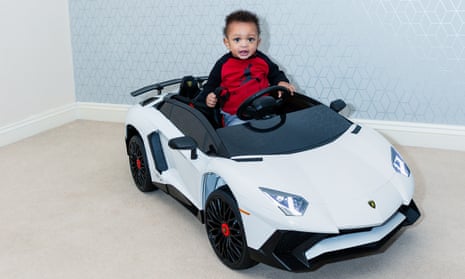Ryan is seven years old and makes a reported $22m (£16.8m) a year. His YouTube channel, Ryan ToysReview, where he made his fortune “unboxing” and reviewing toys, has 18.5 million subscribers – more than official music video channels for Lady Gaga and Ariana Grande. In America, you can go into a toy shop and spend £50 on a large plastic “surprise” egg with his face on it or, for £15, own a toy aeroplane complete with Sky Fighter Ryan, a plastic action figure in his likeness (Space Base Ryan and Commander Ryan are also available; there are 12 to collect).
Ryan (the world does not know his surname) may be the planet’s most successful “kidfluencer”, but he is far from alone. In the UK, there are an estimated 30 or more child vloggers clocking up half a million views per video – such as Tiana, a bubbly 11-year-old toy reviewer from Nottingham (4.4 million subscribers) who has queues of children snaking through shopping centres for meet-and-greets during school holidays. There are hundreds getting more than 100,000 clicks a time, or with six-figure follower counts, such as Harlen White (209,000 on Instagram), the blue‑eyed toddler thought, at one point, to be Britain’s most followed baby.
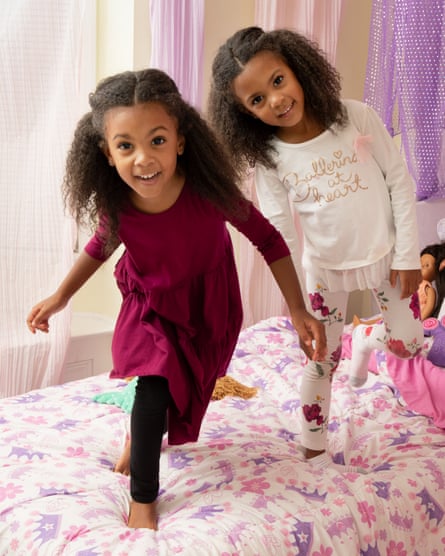
And just as “momagers” pulled the strings for the Hollywood child actors churned out in previous decades, it is parents who are running this generation’s pages. In contrast to the studio system, their children do not have to be taken out of school to spend weeks on set: their everyday lives are at the heart of their appeal. “They’re not celebrities in the traditional sense,” says Britt Bagnall from London-based “kid tech” agency Super Awesome. “But every generation has that same obsessional, cult-like draw towards what is popular, just like the one that wanted to marry Backstreet Boys.”
Launching children on to platforms that were built for adults is not without its difficulties, though. In 2017, the #Adpocalypse saw brands boycott YouTube amid fears that their ads were running alongside questionable content. Last month, the #YouTubeWakeUp movement highlighted concerns over the site’s algorithms, with campaigners showing how they left young users featured in monetised videos vulnerable to child sexual exploitation.
Bagnall started managing social media talent six years ago, and runs a SafeFam scheme offering guidelines and certification for families operating responsibly in the influencer space. “It can be great fun for creative kids, but YouTube is a 13+ platform,” she says. “Channels have to be moderated by a parent, and they have to be transparent about ads and paid partnerships. We couldn’t support content where kids are emotionally exploited or taken out of school to film, or where they are buying their viewers and subscribers. It’s a huge industry, but it’s still the wild west in a way.”
I spoke to a few of the children, pre-schoolers and even babies who are making it big in this untamed landscape.
‘We got plenty of parents saying, “You’re using your kids for attention or fame”’: the McClure family

In New Jersey, US twins Ava and Alexis McClure have achieved a level of fame associated with children of A-listers, such as North West or Blue Ivy. The five-year-old sisters, who were included in Forbes magazine’s inaugural list of top kid influencers in 2017, hit the American consciousness in 2016, when a video of them realising they look the same went viral. The pair, then aged three, chat away adorably while their mother, off camera, explains that they were born a minute apart and have the same face; the clip has now surpassed 5m views. Calls flooded in from Good Morning America, Ellen and The Today Show. Three years on, the duo have collaborated with Disney and Walmart, and count Jessie and D’Lila, the twin daughters of rap titan Diddy, among their friends. “I loved it when we went to California and went horseback riding with them,” says Alexis. “That was my favourite trip.”
There have been plenty more: brands have put on trips to MGM studios in Florida (where they toured out of hours), Puerto Rico and Facebook’s San Francisco HQ. “My mommy and daddy work really hard to make videos and take care of us,” says Alexis. “I think I’m a lucky girl. Sometimes we do videos when we come back from school, and sometimes I just play with my sister. I like it, because people laugh and send messages to us. I try to tell my friends but they don’t believe me.”
“Our teacher watches our YouTube channel and once, when Dad picked us up, she said she loved one of the videos,” says Ava. “We love doing fashion shows and meeting new people and children, too.” Their videos, between eight and 12 minutes long, take their father, Justin, an hour to film and up to 12 hours to edit. Like characters in a social media soap opera, the twins try new toys and hairstyles, play games and learn about life through chats with their mother, as well as “twin talks” together.
Last year, their parents Justin, 44, and Ami, 37, gave up jobs as a training manager at a law firm and an accountant in New York to run the girls’ social media, after doubling their annual household income to half a million dollars. Money is put into savings and investments for the girls, as well as paying for household bills. Their social media stable includes an Instagram grid populated with pictures of the girls in matching outfits and boasting 1.7 million followers, as well as three videos a week across the McClure Twins Family YouTube channel (1.1 million subscribers) and Discovery Twins Facebook show (761,000 followers).
“Their popularity wasn’t something we planned on,” says Ami. “After they went viral, we thought about pros and cons: the girls were naturally dramatic and we could build them a brand, giving them an advantage professionally and financially. But I was afraid of the impact on their privacy and whether it meant they wouldn’t be allowed to grow up just as children. We gave it a shot, keeping full control – no model or talent management.” The family only use a business manager.
“In the beginning, we got plenty of parents saying, ‘You’re using your kids for attention or fame,’” says Ami. “It was hurtful and we hadn’t prepared a thick skin, but in my head I knew where we were going. As our content grew, those comments all but stopped. The thing I always stress is that we work, the girls do not. The only thing fed to them if we do a brand deal is a keyword or concept.”
Each family member now has their own channel, even then twins’ 18-month-old brother Jersey. They can’t walk through a mall or airport without being recognised.
“Their following is bigger than some legit celebs,” says Ami, who plans to hand her daughters control over their content when they turn seven. “If they ask to shut it down, that’s their choice. It’s a pressured world to be part of. At times, we feel we’re not doing enough compared with other accounts, but we prioritise life outside social media. If it all ended tomorrow it would just be an amazing journey that our family shared.”
‘I only go to the park if there are zero kids there’: Tekkerz kid and Thiago
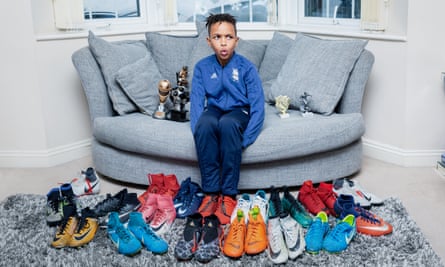
Ten-year-old football prodigy Lorenzo Greer, AKA Tekkerz kid, was six when his father, Nathan, 31, posted a video of him kicking a ball on YouTube. His football skills and cute looks got him noticed, and within a fortnight it had topped 1,000 views. Fast-forward three years, and Lorenzo is one of Britain’s best-known child influencers, with 1.3 million YouTube subscribers – already one-tenth of the way towards adult YouTube veterans Alfie Deyes and Zoella, who have been vlogging for a decade. He also has Instagram and Twitter accounts, his own line in merchandise and a role in a global Nike campaign, alongside French football superstar Kylian Mbappe. Then there are partnerships with toy brands Lego and Hasbro.
“I want to get to 10 million subscribers and get YouTube’s diamond button,” says Lorenzo, from Birmingham. He is polite and his voice brims with excitement when he talks about his brand; he already trains with Birmingham City’s academy and has appeared on both England and Manchester United’s social channels. “Meeting famous footballers – that’s the best part,” he says. “I’ve met Rooney, Gerrard, Rashford. We talk about football and I ask what it was like when they were younger – they tell me to keep working hard.”
Lorenzo’s YouTube fame means he is frequently stopped in the street, often by older kids. During a recent class trip, teachers had to control hordes of teenagers hustling for a selfie. “It first happened when I was seven and in town with my family,” he says. “I was like, ‘Whaaat?’ Sometimes, Dad takes me out of situations if it’s overwhelming. I only go to the park if there are zero kids there.”
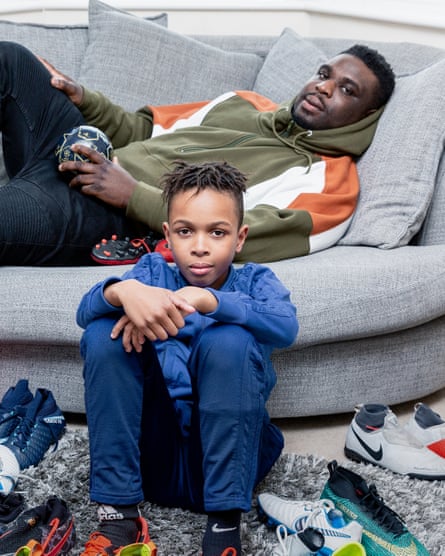
The channel posts one or two 12-minute videos of Lorenzo each week and has had more than a quarter of a billion views in three years. His most popular, with 10m views, was a 2017 challenge where Lorenzo and his brother Romello, now 15, took on YouTube brothers Harry and Josh Lewis, to see who could hit the crossbar and both goal posts first. For every view, the family receives around 2p ad revenue from Google, paid monthly into a limited company. Lorenzo also commands fees to attend events or partner with brands to promote their products. Tekkerz kid earns more than £400,000 a year, according to Nathan – around 15 times the average UK salary. The family’s garage is stuffed full of gifts: sportswear, football boots and toys, much of which will end up being donated to charity.
Lorenzo shoots most of his videos at weekends; in the week he has school and football training. “You’ve got to work hard for it,” he says. “So I tell people to do something they enjoy, like football, and it won’t feel like hard work. Filming a skills video takes about seven to 10 minutes. Dad makes it fun, so we film around the house and do challenges, or prank Romello.”
Nathan and his wife, Tara, edit the videos and manage engagements while the children are in school. They also run a Meet The Greers family channel and Twin VS Twin, featuring Lorenzo’s seven-year-old twin sisters Sariah and Sienna. The family’s earnings, including income from Tekkerz kid, are invested in property, to be inherited by the children when they turn 18.
“There’s an inevitability to Lorenzo’s siblings being on social media,” says Nathan. “We opened up our family and people want to know more. I learned pretty quickly that there was a business in it. It’s about consistency, posting enough videos to keep your audience interested. We were proactive – Tara emailed sports companies and other YouTubers to collaborate. Within a year, it was a full-time job.
“It was a big change for Lorenzo,” he adds. “You go from being normal to being invited to every event. They are spoilt, but they have values instilled in them about hard work. We haven’t had any criticism to our faces, but you get stuff in the comments, saying you’re this and that. I could not care less.”
Lorenzo has no access to the workings of his accounts; these are run by his parents, who also carry out all engagement with followers – a decision to protect him, both from unkind comments and the feeling of work. “Sometimes when I come back from school, Dad tells me some of the funny comments. Then I chill on my phone, have some music on and do my homework. I play with my sisters or my baby brother, Thiago. When I’m 16 or 17, I want him to take over my channel.”
Aged one, and just walking, Thiago has already amassed 34,400 followers on his own Instagram page, including many of Lorenzo’s fans. With his cute smile and big brown eyes, he is photogenic and dresses in on-trend mini-me sportswear. His first newborn shot garnered 10,609 likes, even though his face was pixellated. “A tactical move,” says Nathan. “It generates interest.” In another shot Thiago is cradled by the Formula One driver Nico Rosberg; for his first birthday, he was photographed in a white electric toy Lamborghini, a gift from Mum and Dad.
Nathan says he wants the Tekkerz kid brand to grow up with its followers. “How far we go with Thiago depends on his personality. Lorenzo was outgoing, but it’s not for everyone. You can tell when a kid isn’t happy on camera, and that wouldn’t be fun or fair.”
‘If she’s grumpy, I won’t push her. I make sure she’s doing something that makes her happy’: Lily and Aleksandra Hoyles

At just three years old, Lily Hoyles from south Yorkshire has fashion brands queuing up for her to be photographed in their clothes. She is the tiny, doll-like star of Instagram account @olkafiolka. Her mother Aleksandra, 31, writes posts in English and her native Polish, and provides a careful inventory of featured brands with hashtags such as #cutest_kiddies, #postmyfashionkid and #twinningwithmommy. She fields daily messages from wannabe collaborators hoping to style her daughter and cash in on her 109,000 followers.
It was fellow mothers, both on and offline, who first noticed the potential of Lily and her nine-year-old brother, Liam. “When I first went on Instagram in 2012, I didn’t even know people who followed me could see my pictures,” says Aleksandra, a former warehouse worker. “A few weeks before Lily’s first birthday, in 2016, I posted a picture of her sitting down, wearing a pink pom-pom hat, trainers and handbag. It got 2,040 likes. A few months later, I posted one of her sitting by a window in a blue tutu with knee socks and bows. It got 2,238. More and more fashion pages were sharing her pictures. As the popularity began to grow, a Polish Instamum who followed me featured my page, and our following quickly grew in Poland as well, so I started writing captions in both languages.”
Now Lily’s neatly framed pictures routinely receive upwards of 5,000 likes and 100 comments. But the “threenager”, as Aleksandra jokes with followers, is painfully shy and the images are not always easy to get. “I hide sweets around and have to make sure she is in a good mood, has been fed and had a drink,” she says. “If she’s grumpy, I don’t want to push her. I want to make sure she’s not posing for me – she’s playing or doing something that makes her happy.”

In busy weeks, packages of clothes arrive daily. Lily has received a Gucci outfit, tutus and princess dresses, shoes, bags, play makeup, and an entire set of bedroom furniture. In exchange, Aleksandra tags brands in her photos.
“I’m not very good at the business side,” she says. “Everybody told me that once we got over 50,000 followers, I should be charging for posts so, in the past few months, I have started asking for £50-£100. If it’s a small company I feel guilty and charge less. If it’s something I really want for Lily, I don’t always charge.” Aleksandra, whose husband Piya, 34, is a building contractor, spends around four hours a day editing photos, managing emails and responding to comments. “I see what we are doing as creating opportunities to give our children things we could not otherwise afford.”
Lily’s privacy is guarded. “I was scared when the following started to grow. I don’t say where I’m going, where we’re from, or tag locations. I don’t get that much negative feedback – maybe once every month. Once I posted on Stories that she was being grumpy and one lady responded to say she was spoilt. People are very quick to judge – I don’t think she’s spoilt. I do get annoyed and hurt on Lily’s behalf, but I just say, ‘You don’t know me and I don’t know you.’”
‘If I shoot videos for younger kids, there are a lot who want to watch. I’m clever’: Louise’s Unicorn Power Puff Girl
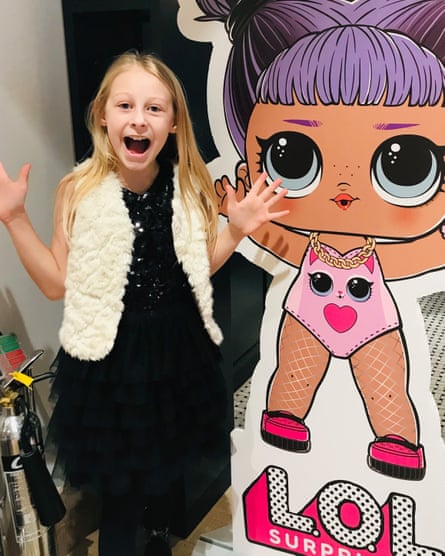
In the bedroom of nine-year-old Louise’s Kent home is a makeshift studio: a presenting station, lights and a green screen used to feed the 10,000 YouTube subscribers to her toy review channel, Louise’s Unicorn Power Puff Girl (LUPPG).
“I got the inspiration from watching kids unwrapping Kinder eggs on YouTube, and I wanted to be famous,” says Louise, who grew her following opening LOLs, the cult dolls driving social media’s craze for “unboxing” new toys. She begged her mum, Donna, 39, to film her first video in a pub garden in July 2017.
“It just took off,” says Louise. “Once we hit 10,000 views, subscribers started coming in. After a year, I had 8,000. Then we moved to toy reviews and set up an Instagram page.” She now has 12,700 followers on the photo-sharing site and charges brands three-figure sums to share videos of their products across the two platforms.
“Back when I started, I got quite a few hate comments. Mum said: ‘Just ignore them, they’re jealous of how far you’ve come.’ We look at the comments together and discuss them; it helps me learn how to respond to good and bad things in life. There are some boys in school who tease me or say I pay for ads. We don’t even know how to. I ignore a lot of it – there are enough nice people out there.”
Louise has partnered with Mattel on a Barbie promotion, travelled to private movie screenings and receives about five toys to review each week. She films two or three 10- to 12-minute YouTube videos a week, usually at the weekend, and her mum posts on her Instagram at least once a day, as well as contacting brands about collaborations. Ad revenue and video fees go towards shopping trips for Louise and, this year, a family holiday to Disney World in Florida. The channel was bringing in around £800-£1,000 a month in the early days, but less since the LOL craze tailed off.
“I leave the business side to mum,” says Louise. “But I’ve made friends with other YouTuber kids – I feel like they understand what I’m talking about. Some of the toys I do are really babyish, but I realised that if I shoot videos for younger kids, there are a lot of them out there who would want to watch. I’m clever.”
In the future, Louise hopes to become a TV presenter or actor. “I want to move on from toys to makeup,” she says. “I love filming with my mum. The thing I enjoy most is getting positive comments, so I feel good about myself. One time, in Bluewater shopping centre, these three teenage girls were staring at me. Then, in the lift, they asked, ‘Are you Louise’s Unicorn Power Puff Girl?’ I said: ‘I sure am.’ That was cool.”
